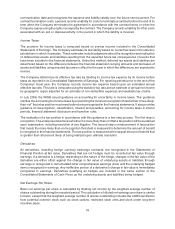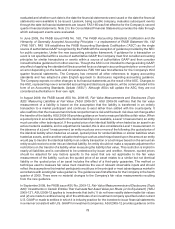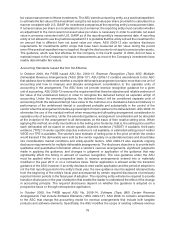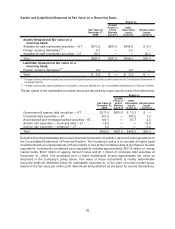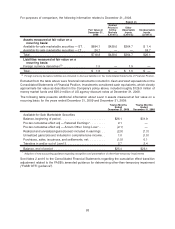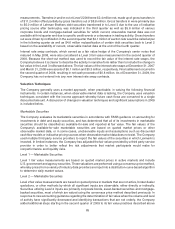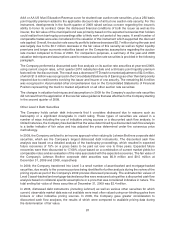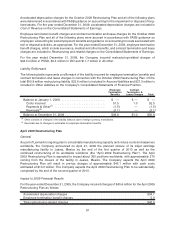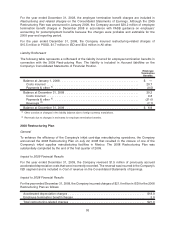Lexmark 2009 Annual Report Download - page 91
Download and view the complete annual report
Please find page 91 of the 2009 Lexmark annual report below. You can navigate through the pages in the report by either clicking on the pages listed below, or by using the keyword search tool below to find specific information within the annual report.measurements. Transfers in and/or out of Level 3 2008 were $2.4 million net, made up of gross transfers in
of $11.2 million offset partially by gross transfers out of $8.8 million. Gross transfers in were primarily due
to $5.0 million of Lehman Brothers debt securities transferred in to Level 3 due to the use of indicative
pricing source after bankruptcy was indicated in the third quarter as well as $5.6 million of various
corporate bonds and mortgage-backed securities for which current, observable market data was not
available at third quarter end due to specific credit events or a decrease in trading activity. Gross transfers
out were driven by notification in the second quarter that $4.1 million of auction rate would be called at par
in the following quarter as well as $4.6 million reclassification of certain debt securities back to Level 2
based on the availability of current, observable market data at the end of the fourth quarter.
Interest rate swap contracts, which served as a fair value hedge of the Company’s senior notes that
matured in May 2008, were also considered a Level 3 fair value measurement in the second quarter of
2008. Because the short-cut method was used to record the fair value of the interest rate swaps, the
Company believes it is clearer to describe the activity in narrative form rather than to include the change in
fair value in the Level 3 rollforward above. The fair values of the interest rate swaps at December 31, 2007
and March 31, 2008 were assets of $0.1 million and $0.3 million, respectively. Final settlement occurred in
the second quarter of 2008, resulting in net cash proceeds of $0.8 million. As of December 31, 2009, the
Company has not entered into any new interest rate swap contracts.
Valuation Techniques
The Company generally uses a market approach, when practicable, in valuing the following financial
instruments. In certain instances, when observable market data is lacking, the Company uses valuation
techniques consistent with the income approach whereby future cash flows are converted to a single
discounted amount. A discussion of changes in valuation techniques and significant assumptions in 2009
is included below.
Marketable Securities
The Company evaluates its marketable securities in accordance with FASB guidance on accounting for
investments in debt and equity securities, and has determined that all of its investments in marketable
securities should be classified as available-for-sale and reported at fair value. The fair values of the
Company’s available-for-sale marketable securities are based on quoted market prices or other
observable market data, or in some cases, unobservable inputs and assumptions such as discounted
cash flow models or indicative pricing sources when observable market data does not exist. The Company
used multiple third party service providers to report the fair values of the securities in which Lexmark is
invested. In limited instances, the Company has adjusted the fair values provided by a third party service
provider in order to better reflect the risk adjustments that market participants would make for
nonperformance and liquidity risks.
Level 1 — Marketable Securities
Level 1 fair value measurements are based on quoted market prices in active markets and include
U.S. government and agency securities. These valuations are performed using a consensus price method,
whereby prices from a variety of industry data providers are input into a distribution-curve based algorithm
to determine daily market values.
Level 2 — Marketable Securities
Level 2 fair value measurements are based on quoted prices in markets that are not active, broker dealer
quotations, or other methods by which all significant inputs are observable, either directly or indirectly.
Securities utilizing Level 2 inputs are primarily corporate bonds, asset-backed securities and mortgage-
backed securities, most of which are valued using the consensus price method described previously. In
response to new accounting guidance regarding the determination of fair value when the volume and level
of activity have significantly decreased and identifying transactions that are not orderly, the Company
added additional steps starting in the second quarter of 2009 to its fair value practices described above
85


